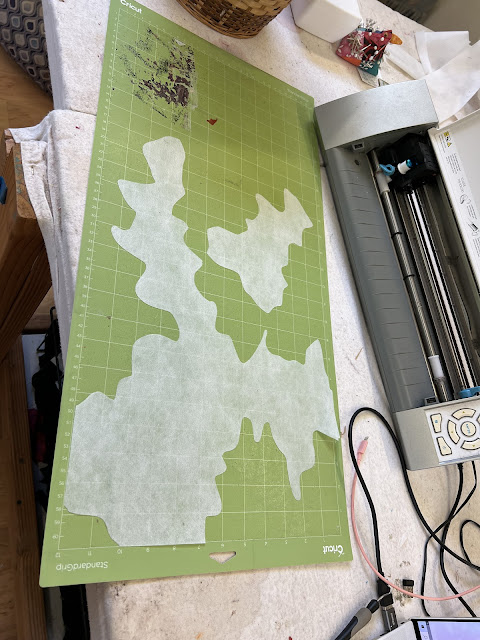Earlier this week I shared about the first quilt I made for our Living Language Land inspired quilt show. My second piece also used the topography approach and in fact re-used one section of the pattern from my
based on the USGS topo maps of the mountains where I grew up in southern New Mexico.
The word I picked was Tuuca Orodji
From the Living Language Land website:
Rainwater pan
When I think of collecting rainwater, I think of all the little creeks in each canyon of our mountains. They only run for just a few months out of the year: when the summer monsoons come and in the spring when there is runoff from the snow melt. I remember having such a good time playing in the creeks on the rare occasions they had water. The section of topo map I chose features the canyon through which north Eagle Creek flows.
Here are some in-progress pictures as I cut out the pieces on my silhouette and layed them out for painting.
And here is in progress with the layering. Each layer is separated by a plastic pony bead to give depth.
And here is in progress with the layering. Each layer is separated by a plastic pony bead to give depth.
Here's the finished piece with artist statement below.
I'm interested in how the processes of layering and then taking away can create dimension and shape. Layer after layer is peeled away to expose what's underneath: organic openings that shift in shape, color, and depth. This piece began with hand painted cloth and a machine quilted base, and then are layered and/or cut away, and anchored with hand stitching. Each layer corresponds to a 160ft topo line from a USGS map of the White Mountain Wilderness in southern New Mexico. This region of New Mexico continues getting drier and drier, with endemic forest fires and water collecting in canyon bottoms for only a few short weeks each spring.
Our goal as show organizers was to have at least two quilts for each word, and at the end of the call for entry period we still had a few words left. In looking through them, it occurred to me that one of them, Itrofillmongen, would fit fairly well with a small 12x12 quilt I made in 2015 and still had.
The quilt was made as part of a small series featuring a lady (me actually) looking out a window. The point of the series was to capture the ambiguity of poster and expression, and let the viewer imagine what was occurring. That seemed to fit well with
Itrofillmongen
from the Living Language Land website:
Language: Mapudungun
Region: Lake Budi, Mapuche Territory, Chile
Contributor: Fernando Quilaqueo, Environmental Association Budi Anumka
The tangible and intangible elements of the diversity of life
Artist statement: This piece was inspired by the relationship between us, standing alone in the darkness, and the piercing lightness of the world outside.
I'm looking forward to seeing the Living Language Land exhibit all together, I think it's a very interesting idea.











Wow! Beautiful work!
ReplyDelete